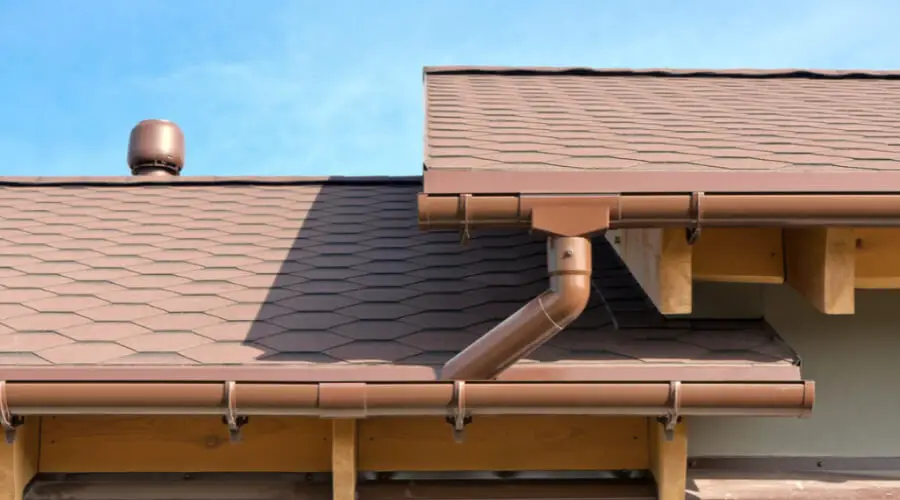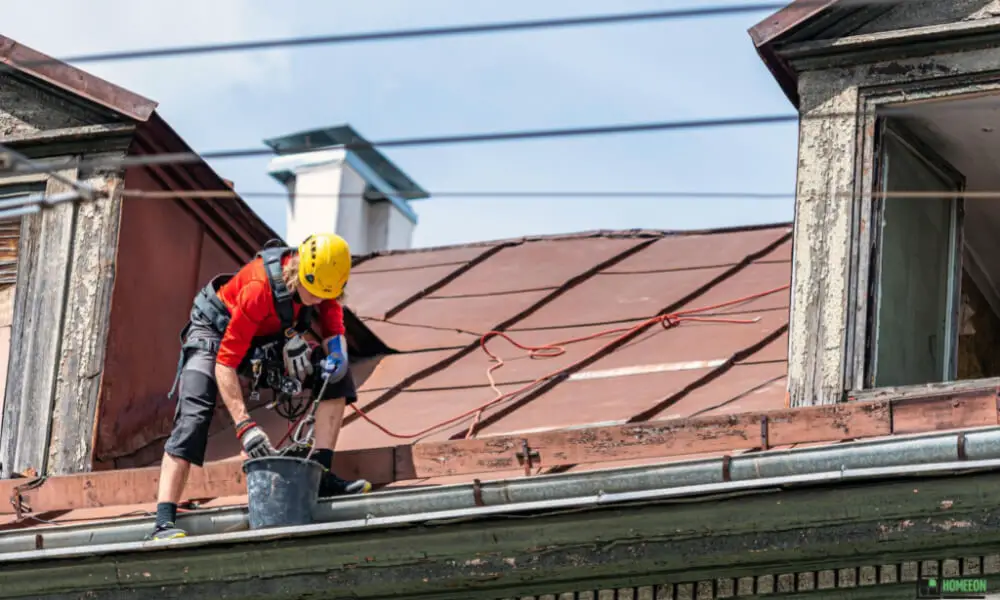Last Updated on July 18, 2023 By Emma W. Thomas
Yes, you should install gutter flashing when installing a new roof gutter. It acts as a protective barrier, preventing water from seeping into the roof and causing damage. The flashing is typically made of metal and is installed along the edge of the roof, overlapping the gutter. It helps to channel rainwater away from the roof and into the gutter system, ensuring proper drainage.
Reasons You Should Use Gutter Flashing When Installing A New Roof Gutter
Using gutter flashing when installing a new roof gutter offers several important benefits:
- Water Protection: Gutter flashing acts as a barrier, preventing water from seeping into the roof and causing damage. It directs rainwater into the gutter system, keeping the roof and underlying structure dry and free from potential leaks.
- Preventing Rot and Mold: Without flashing, water can infiltrate the roof’s fascia, soffit, and other vulnerable areas, leading to rot and mold growth. Gutter flashing helps protect these components, prolonging the life of the roof.
- Preserving the Roof’s Integrity: By preventing water damage, flashing maintains the integrity of the roof. It ensures that the roof’s structural elements stay strong and prevents costly repairs in the long run.
- Foundation Protection: Properly channeled water away from the roof prevents erosion around the foundation, safeguarding the entire structure’s stability.
- Reducing Maintenance: Gutter flashing reduces the amount of debris that enters the roof’s edges, minimizing clogging and the need for frequent gutter cleaning.
- Preventing Ice Dams: In colder climates, flashing helps prevent ice dams from forming at the roof edge, reducing the risk of ice-related damage.
- Enhancing Aesthetics: Gutter flashing provides a finished look to the roof’s edges, improving the overall appearance of the building.
- Compliance with Building Codes: Many building codes require the use of gutter flashing as part of proper roofing installations.
What Is Gutter Flashing?
Gutter flashing is a tool installed beneath the roofline and in the gutter. The roofline can also be called fascia. This tool is used together with another known as a drip edge.
Gutter flashing and the drip edge work together to prevent water from slipping into the building and destroying the house. Gutter flashing is installed at an angle of 35 degrees to better divert running rainwater into the gutter and not into the building.
Drip edge flashing prevents water from being blown back into the roof shingles, protects them from dripping water, and seals the gap between the roof shingles and gutters.
Types Of Gutter Flashing

There are a few types of gutter flashing commonly used across the country. Some of them include:
Step Flashing
With this gutter flash, a rectangular piece of slashing is bent 90 degrees in the center. It is mainly used for roof-to-wall flashing. This sort of flashing prevents water from getting over to the other side.
Continuous Flashing
Apron flashing is another name that is used to describe continuous flashing. One long piece of a continuous flash is installed. This flashing protects the meeting point of the wall and the slanting roof.
Vent Pipe Flashing
Vent pipe flashing is a cone-shaped fitting installed into the shingles to cover the pipes.
Valley Flashing
Valley-shaped flashing is made with a “W” shaped piece of metal flashing. The “W” shaped flashing is placed where two valleys of a roof plane join.
Drip Edge
Drip edge flashing is installed under the roofing felt along the eaves of a roof. It helps water drip off the roof and into the gutter without flowing into the house and the walls.
How Is Gutter Flashing Installed?
Gutter flashing is installed along the edge of the roof where the gutter is positioned. Here’s a general step-by-step guide on how it’s done:
- Prepare the area: Ensure the roof and gutter are clean and free from debris. Safety precautions like using a ladder and wearing appropriate gear are essential.
- Measure and cut the flashing: Measure the length of the roof edge where the gutter will be attached. Cut the gutter flashing to match the measurements using metal shears or tin snips.
- Position the flashing: Place the flashing along the roof edge, allowing it to overlap the gutter. The flashing’s wider part should go under the shingles or roofing material, while the narrower part goes over the back of the gutter.
- Secure the flashing: Nail or screw the flashing into place. Use appropriate fasteners (such as galvanized nails or stainless steel screws) to ensure durability and prevent rusting.
- Seal the joints: To ensure a watertight seal, use roofing caulk or sealant to fill any gaps or joints where the flashing meets the roof and gutter.
- Test the installation: Check for any leaks or loose areas by running water through the gutter. Make adjustments as necessary.
- Inspect and maintain: Regularly inspect the gutter flashing for damage or wear and replace it when needed. Keeping the flashing in good condition is crucial for its proper functioning.
What Is The Importance Of Gutter Flashing?
Gutter flashing blocks water from dripping behind the gutter and the home wall. Besides, it has other advantages as highlighted below:
- Prevents damage to the siding, interior wall studs, and interior home walls
- Prevent the formation of mildew, mold, and rotting. These protect your home from water damage and also your health.
- Protects roof from the sheathing
- Prevent siding from staining
- Act as a sealant between your gutters and your roofline
- Increases the efficiency of your roof and gutters
How To Maintain Gutter Flashing
Maintenance steps for gutter flashing are almost the same as those used to maintain gutters and roofs. Some of these comprise:
- Regular check-ups after heavy rainfall or destructive weather
- Repair and replacement of broken or torn parts.
- Cleaning up clogged gutters
- Use a professional to have your gutters and gutter flashing well set up.
- Regular water damage signs check-ups. Water damage is not easily detected in the beginning; regular check-ups can warn you of leaks.
- Use enough adhesive when installing the gutter flashing.
- Fix damages as soon as you know there are damages.
- Regularly clean your roof.
- Trim trees surrounding your house.
- Remove rust and any rusted parts as they will break off and destroy the entire gutter and gutter flashing.
Gutter Flashing Installation Cost
Gutter flashing comes in different materials that determine the cost. Some of these materials include:
- Aluminum
- Copper
- Vinyl
- Galvanized steel.
Copper gutter flashing is the most expensive and costs about 30 dollars. Aluminum, vinyl, and galvanized steel cost less than 10 dollars.
Final Thought
Gutter flashing is an important installation in your house; it has many advantages that will ultimately reduce repair or replacement costs in the long run. Water damage can cause huge cost implications for the homeowner if not well managed.
Installing gutter flashings is a preventive measure that will help you out. The cost of gutter flashing is relatively low compared to the damages if not installed.
References:
https://www.telgeroofing.com/blog/2020/november/what-is-gutter-flashing-and-why-is-it-so-importa/
https://www.yourownarchitect.com/do-you-need-gutter-flashing-how-to-decide/
Emma is a graduate of Domestic Science or Family and Consumer Sciences (Home Economics) from the University of Wisconsin. She has 7 years of experience Working with the strategic section of BestBuy and now writing full-time for Homeeon.
From Managing the Home, Interiors, Cleaning, and Exteriors to Gardening and everything about Making A Home Liveable – is her passion and this Homeeon is the result of this.
Emma loves decorating her home with the best stuff found online. She cares about quality over anything and writes reviews about them here in Homeeon. Get in touch with her over Pinterest.
Keep reading her blogs.

